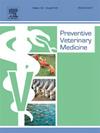中华人民共和国湖北省山羊群体布鲁氏菌抗体的真实流行率和空间分布:消除疾病的进展
IF 2.2
2区 农林科学
Q1 VETERINARY SCIENCES
引用次数: 0
摘要
绵羊布鲁氏菌病主要由山羊布鲁氏菌引起,在世界范围内仍然是一种重大的人畜共患威胁,影响动物生产力、福利和公共卫生。本研究旨在了解湖北省山羊群体中布鲁氏菌抗体的真实流行率和空间分布。2021年,从湖北省16个市辖区82个县的23126只山羊群中采集了约140万份血清样本。采用玫瑰孟加拉试验和血清凝集试验的组合来检测布鲁氏菌抗体。采用分层贝叶斯潜类模型来解释检测的不完善的诊断敏感性和特异性,两种检测之间的条件依赖性,以及分层数据结构来估计TP和达到95% %的概率的概率TP低于0.1 %。动物和畜群水平的表观患病率分别为0.051 %和0.536 %。82个县的动物水平TP中位数为0.0088 %(范围:0.0008 %,9.3730 %),其中76.8% %的县TP中位数估计值低于0.1 %。阳性山羊县主要集中在黄冈市和黄石,与阳性县接壤的县血清阳性风险较高。值得注意的是,52.4 %的县实现了95 %的概率,TP低于0.1 %。敏感性分析证实了这些发现在先前分布中的稳健性。结论认为,湖北省在消除山羊布鲁氏菌病方面取得了显著进展,应优先对阳性县及其周边县进行干预。本文章由计算机程序翻译,如有差异,请以英文原文为准。
True prevalence and spatial distribution of antibodies to Brucella spp. in goat populations in Hubei Province, People’s Republic of China: Progress toward disease elimination
Caprine brucellosis, mainly caused by Brucella melitensis, remains a significant zoonotic threat worldwide, affecting animal productivity, welfare, and public health. This study aimed to estimate the true prevalence (TP) and spatial distribution of antibodies to Brucella spp. among goat populations in Hubei Province, China. In 2021, approximately 1.4 million serum samples were collected from 23,126 goat flocks across 82 counties of 16 municipal regions of Hubei Province. A combination of the Rose Bengal Test and Serum Agglutination Test in series was used to detect antibodies against Brucella spp. A hierarchical Bayesian Latent Class Model was used to account for imperfect diagnostic sensitivity and specificity of the tests, conditional dependence between the two tests, and hierarchical data structure to estimate the TP and the probability of achieving a 95 % probability of having a TP below 0.1 % for each county and municipal region. Apparent prevalence was 0.051 % and 0.536 % at the animal and flock level, respectively. The median animal level TP in the 82 counties was 0.0088 % (Range: 0.0008 %, 9.3730 %), with 76.8 % of counties showing a median TP estimate below 0.1 %. Counties containing positive goats were mainly clustered in Huanggang and Huangshi, and counties bordering positive counties had a higher risk of seropositivity. Notably, 52.4 % of counties achieved a 95 % probability with a TP below 0.1 %. Sensitivity analyses confirmed the robustness of these findings across prior distributions. It was concluded that Hubei Province has achieved remarkable progress in caprine brucellosis elimination programs, and priority interventions should be given to positive counties and their bordering counties.
求助全文
通过发布文献求助,成功后即可免费获取论文全文。
去求助
来源期刊

Preventive veterinary medicine
农林科学-兽医学
CiteScore
5.60
自引率
7.70%
发文量
184
审稿时长
3 months
期刊介绍:
Preventive Veterinary Medicine is one of the leading international resources for scientific reports on animal health programs and preventive veterinary medicine. The journal follows the guidelines for standardizing and strengthening the reporting of biomedical research which are available from the CONSORT, MOOSE, PRISMA, REFLECT, STARD, and STROBE statements. The journal focuses on:
Epidemiology of health events relevant to domestic and wild animals;
Economic impacts of epidemic and endemic animal and zoonotic diseases;
Latest methods and approaches in veterinary epidemiology;
Disease and infection control or eradication measures;
The "One Health" concept and the relationships between veterinary medicine, human health, animal-production systems, and the environment;
Development of new techniques in surveillance systems and diagnosis;
Evaluation and control of diseases in animal populations.
 求助内容:
求助内容: 应助结果提醒方式:
应助结果提醒方式:


